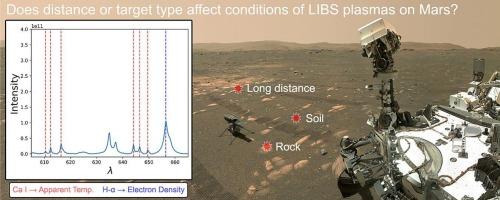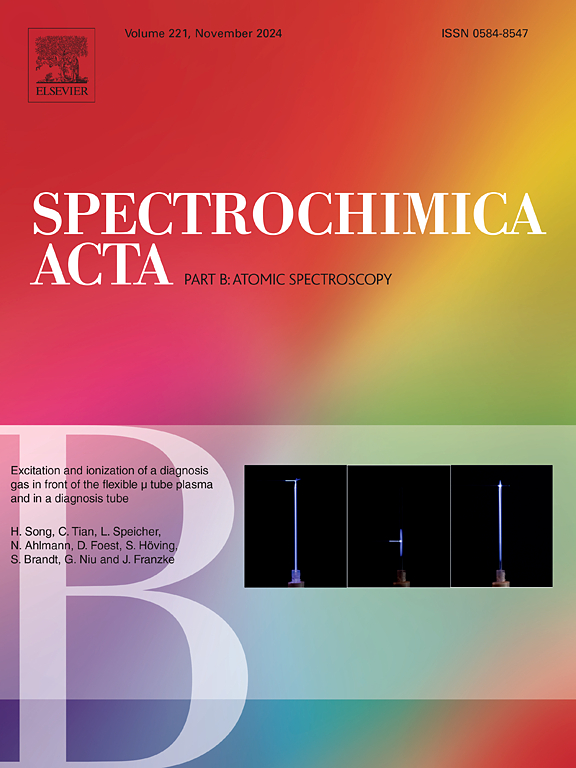利用超级相机对火星上的 LIBS 等离子体进行诊断:对元素丰度量化的影响
IF 3.2
2区 化学
Q1 SPECTROSCOPY
引用次数: 0
摘要
毅力号 "漫游车于 2021 年在火星杰泽罗陨石坑着陆,探索一个古老的三角洲,寻找过去生命的迹象,并为未来的火星采样返回任务采集样本。毅力号 "上的 "超级相机 "利用激光诱导击穿光谱仪(LIBS)对漫游车穿越过程中遇到的岩石/土壤中的元素进行量化。激光诱导击穿光谱仪在行星科学任务中是非常理想的,因为它在远距离和不同目标类型(岩石、土壤等)下都很有效。然而,激光辐照度随距离的增加而降低,不同目标的耦合效率也在变化,这些都可能导致等离子体羽流的物理条件发生变化,从而对 SuperCam 的元素校准产生重要影响。本研究通过多线玻尔兹曼图法估算表观温度,并利用 H-α 线的斯塔克展宽法估算电子密度,研究了火星上激光诱导等离子体的特征。我们发现表观等离子体温度不会随着距离的增加而降低,也不会随着目标类型(岩石与土壤)的不同而发生系统性变化。火星上等离子体温度的变化在用于 SuperCam 元素校准的实验室数据集中得到了充分体现,这表明我们的元素校准可能对观测到的视等离子体温度变化具有稳健性。土壤中的估计电子密度比岩石目标中的高 1.4 倍,这可能与 H-α 线对地形起伏的依赖性有关,这种机制还不太清楚,导致火星光谱中氢丰度难以量化。本文章由计算机程序翻译,如有差异,请以英文原文为准。

LIBS plasma diagnostics with SuperCam on Mars: Implications for quantification of elemental abundances
The Perseverance rover landed in Jezero Crater, Mars, in 2021 to explore an ancient delta for signs of past life and collect samples for a future Mars Sample Return Mission. SuperCam, onboard Perseverance, uses Laser Induced Breakdown Spectroscopy (LIBS) to quantify the elements in the rocks/soils encountered along the rover's traverse. LIBS is desirable for planetary science missions because of its effectiveness at a distance and with different target types (rock, soil, etc). However, decreased laser irradiance with distance and changing coupling efficiency in different targets could cause the physical conditions of the plasma plume to vary, with important implications for SuperCam's elemental calibration. This study examines the characteristics of laser-induced plasmas on Mars by estimating apparent temperature via the multiline Boltzmann plot method and electron density using Stark broadening of the H-α line. We find that apparent plasma temperatures do not decrease with distance or vary systematically with target type (rock vs soil). The variability in plasma temperatures seen on Mars is fully represented in the laboratory dataset used for SuperCam's elemental calibration, which suggests that our elemental calibration is likely robust against observed changes in apparent plasma temperature. These results imply that SuperCam can make reliable LIBS observations to at least 8 m. Estimated electron density is 1.4× higher in soils than rock targets, which is likely related to the dependence of the H-α line on topographic relief, a poorly understood mechanism which contributes to the difficulty of quantifying hydrogen abundance in Mars spectra.
求助全文
通过发布文献求助,成功后即可免费获取论文全文。
去求助
来源期刊
CiteScore
6.10
自引率
12.10%
发文量
173
审稿时长
81 days
期刊介绍:
Spectrochimica Acta Part B: Atomic Spectroscopy, is intended for the rapid publication of both original work and reviews in the following fields:
Atomic Emission (AES), Atomic Absorption (AAS) and Atomic Fluorescence (AFS) spectroscopy;
Mass Spectrometry (MS) for inorganic analysis covering Spark Source (SS-MS), Inductively Coupled Plasma (ICP-MS), Glow Discharge (GD-MS), and Secondary Ion Mass Spectrometry (SIMS).
Laser induced atomic spectroscopy for inorganic analysis, including non-linear optical laser spectroscopy, covering Laser Enhanced Ionization (LEI), Laser Induced Fluorescence (LIF), Resonance Ionization Spectroscopy (RIS) and Resonance Ionization Mass Spectrometry (RIMS); Laser Induced Breakdown Spectroscopy (LIBS); Cavity Ringdown Spectroscopy (CRDS), Laser Ablation Inductively Coupled Plasma Atomic Emission Spectroscopy (LA-ICP-AES) and Laser Ablation Inductively Coupled Plasma Mass Spectrometry (LA-ICP-MS).
X-ray spectrometry, X-ray Optics and Microanalysis, including X-ray fluorescence spectrometry (XRF) and related techniques, in particular Total-reflection X-ray Fluorescence Spectrometry (TXRF), and Synchrotron Radiation-excited Total reflection XRF (SR-TXRF).
Manuscripts dealing with (i) fundamentals, (ii) methodology development, (iii)instrumentation, and (iv) applications, can be submitted for publication.

 求助内容:
求助内容: 应助结果提醒方式:
应助结果提醒方式:


